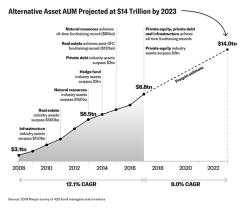With their appetite for private market investments perhaps larger than ever, institutional investors face a risk modeling challenge that is extraordinarily complex but nonetheless critical to effective asset allocation.

Of the many considerable variables in modeling risk for a private market portfolio, liquidity considerations are generally near the top of the list of challenges. “If you’re accustomed to investing exclusively in traditional markets, private market investments will likely have an impact on your liquidity profile,” says Neil Blundell, Global Head of Client Solutions at Invesco. “You may be going into vehicles that are open-ended but with less frequent redemption periods. Or maybe the investment vehicle is a closed-end vintage structure, and you’re unable to recoup the capital you’ve invested until the investment objective is achieved. Even in the case of open-ended funds with relatively frequent redemption periods, though, investors still need to evaluate their liquidity needs and other considerations around investments in private, less liquid assets.”
Public proxies for private markets
An integral part of the modeling process at Invesco involves Blundell and his colleagues on the Invesco Global Solutions team breaking down private market asset classes into underlying factor exposures, which often includes establishing appropriate public proxies for those exposures so that individual components and the risks they each bring to the portfolio can be understood.
“In modeling private equity, for example, we’ll relate back to public equities,” says Blundell. “While public proxies will not fully reflect the behavior of private assets, if you think about the composition of private equity exposures, public proxies allow for a really market-focused map of the broad drivers of risk and return. Using that as a foundation, we’ll incorporate additional elements – a liquidity premium, for example, or the use and cost of leverage. Are you going small, mid, large, or are you going to focus on specific regions versus looking more globally? Incorporating all these pieces and some added modeling considerations around different strategies help us to capture the impact of private asset classes in the portfolio.”
Sticking with the private equity example, in a US large cap buyout, the proxy might start to take shape with the MSCI USA Index. An early stage venture might use small cap, healthcare, IT, or telecom as the starting point for its proxy, depending on the industry focus. At the mezzanine level, the proxy could start from a high yield index in US dollars or euros, and build from there.
Once a comprehensive view of the underlying risk exposures has been established, the forecasted risk of the asset class itself can be considered. “Private markets will, in many cases, give you unique exposures, but some of the component parts will still be correlated to other investments in the portfolio. Understanding these correlations through a factor lens gives a clearer view of the diversification potential that private asset classes may provide within the portfolio, and where those exposures may still be correlated to traditional markets,” says Blundell.
Much of the proxy modeling work done on potential private market investments by Invesco involves scenarios that provide a comprehensive view of risks. “We try to help investors see the risks in easy to understand ways,” says Nicholas Savoulides, Head of Global Solutions Research at Invesco. “For example, if there is a 10% drawdown in the S&P, what happens to different private market asset classes even though they aren’t part of that public market drawdown? Or what happens to various subsectors of private markets if rates drops in a particular country?”

Addressing investors’ specific internal challenges
Investors know well the many internal hurdles they face in allocating to private markets. Understanding the risks and their proxies, and aggregating overarching factor risk is the starting point for modeling, but more is revealed when Invesco’s solutions team considers the challenge from a client’s practitioner view.
Insurance companies, for example, have relied on fixed income portfolios as the bread and butter of their asset and liability matching for a long time, and it has worked for them. But the CIO at an insurer would have to view any private market investments through a solvency lens in order to meet solvency capital requirements and avoid stringent capital charges.
“We can help clients not only navigate what’s an optimal return, but also what an optimal return is in the context of internal challenges, regulatory issues, board issues, and, in the case of insurers as an example, for solvency and capital ratio challenges,” says Blundell. “In some cases, it comes down to whether you can buy a fund or if it needs to be a managed account, because you’ll get different capital charges against each of those. With our analytics platform we can see what an efficient frontier looks like based on your existing portfolio, and we have the flexibility in our program to re-optimize for Solvency II. Having that flexibility and infusing our practitioner views, especially where we understand the nuances of something like insurance regulation, helps guide clients through some of the investment challenges they face.”
Start the conversation on better outcomes. Learn more.
All content provided by Invesco is for informational purposes only and is not an offer to buy or sell any financial instruments.
The opinions expressed are those of the authors, are based on current market conditions and are subject to change without notice. These opinions may differ from those of other Invesco investment professionals
Invesco Advisers Inc. is an investment adviser; it provides investment advisory services to individual and institutional clients and does not sell securities.
Asset allocation, diversification and low or negative correlation do not guarantee a profit or eliminate the risk of loss.
Factor investing is an investment strategy in which securities are chosen based on certain characteristics and attributes.
Solvency II is the regulatory directive for insurance organizations within the European Union.
Alternative products typically hold non-traditional investments and may employ complex trading strategies. Investors considering alternatives should be aware of their unique characteristics and additional risks from the strategies they use.





